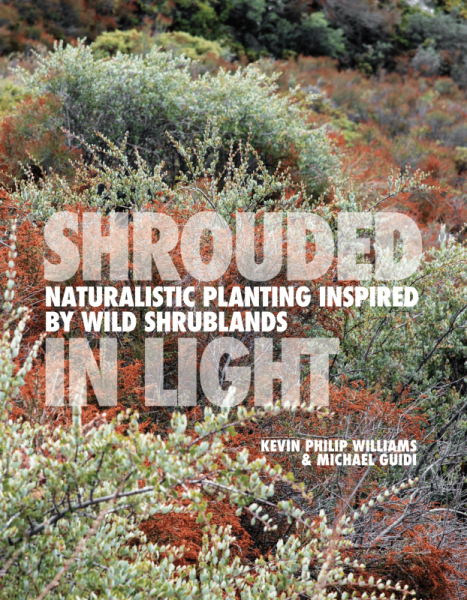
Shrouded in Light: Naturalistic Planting Inspired by Wild Shrublands by Kevin Philip Williams & Michael Guidi Filbert Press, 2024.
$550. List, $40.95 Amazon
An average garden reader looking for a practical guide to hold their hand for a how-to approach to gardening with shrubs will not only be happy, but knocked off their feet and thrown off a kaleidoscopic fray of colorful shards of shattered status-quo. Those that stay upright for the ride are treated to a rich three-course meal of steak. Shrouded in Light, with even a little self-contradiction woven into the title, follows its own very unique and personal course- like a poem, with punk music woven into its ethos. Philosophical, it ties shrubs into horticulture, human culture, emotion and damn near everything else.
I think botanically sophisticated rock garden readers have the broad background knowledge (including esoteric terms) needed to understand it, but those who are strict adherents to alpine worship will either not find much for their bias or will enjoy the enrichment of a fresh look at a different biome and plant type. It’s a deep dive into a narrow thing- extreme depth- and perhaps depending on a reader’s taste, at the expense of breadth. Any instruction is by accident: Shrouded calls for destruction of the old, fairly shy of providing a single direction of a new alternative- which seems intentional. The engaged reader is left to find their own taste and direction while recognizing the authors own strong aesthetic bias. I’m not at all upset by their bias for patterns of rusty red and sage green or chartreuse- maybe some readers will tire of a couple hundred pages of it. Since my schooling was art and not horticulture, I’ve long broken down landscapes as abstract paintings in my eye, and it was novel to see that inked on paper here, and I hope readers find that formalization to be an empowering lens.
Frankly, with the art and intention message so strong, I wondered why it needed tying to bushes; perhaps because shrubbery was the mere door into the bigger room, being a current underdog in horticulture. Shrubs have indeed been given the stepchild treatment in recent garden thinking and design, always peripheral to another focus. In fact, despite Doug Tallamy’s early movement-starting wildlife-gardening works giving equal if not greater attention to woody plants (for larval forage and general habitat), the current meadow movement, (which I’m joyfully wallowing in myself) as well as the fastest-growing part of the native and wildlife-gardening movement, often focus exclusively on expansive herbaceous plantings.
A vacuum is left, even after this book, to address the practical and better use of shrubs in widespread (and traditionally the least sophisticated) city landscape use because of their longevity and generally low maintenance. Some regions (like the Midwest) are learning that their ground wants to be a prairie, and great parts of the west need aesthetic representatives and poster children to legitimize shrub-dominated design. In fact, I recall that I realized this overhearing a conversation between rock gardeners of NARGS’ Wasatch chapter, remarking that just as grass and forbs make sense in Denver, if Salt Lake City and the Great Basin finds its local spirit, it would be desert shrubland, or sagebrush steppe. Like Denver Botanic’s 2015 Steppes book, Shrouded breaks the ice on a forgotten and important subject, hopefully to be followed by further angles and treatments and corners of the subjects.
Shrouded in Light really goes buck in its intention to inspire the use of shrubs, from its unique angle of interest. (Everyday readers who want to be gently romanced into a love for shrubs, through flowering ones, say, will not get it but be met with a dive straight into the deep end of a church sermon of texture, structure, and autumn- and stem-color worship. These are indeed things garden designers talk about but haven’t fleshed out as Guidi and Williams did here. Energized by Guidi, the images pull the naturalistic garden book standard back up to a Saxon Holt era of garden and nature photography. A reader bewildered by the content can take refuge in its gorgeous, atmospheric images. Williams approaches an abundance of shrub-related subjects like a contemporary garden beatnik, boldly risking inaccessibility but absolutely ensuring that there is some wildly novel gem found in that menagerie that is very new or very inspiring to any reader. Personally, it's a bit of a relief from a the pandering trend of so much singularly sales-driven but soulless material which absolutely avoids challenging or surprising the reader in any way that they hadn't already signed up for. I think Shrouded is probably a garden book most unlike any other I have read. Not playing it safe, it’s an artistic and philosophical ride for sophisticates, a deep dive into a crack in current progressive horticulture that needs light, however indirect, shined brightly into it.
Kenton Seth is well known to rock gardeners as the co-author, with Paul Spriggs, of The Crevice Garden and creator of public and private crevice gardens around the world.
